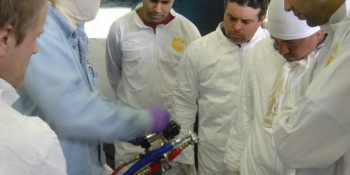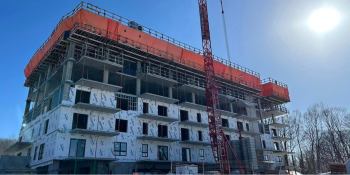Q&A Forums
INJECTION FOAM?????? Post New Topic | Post Reply
| Author | Comments |
|---|---|
|
daniel kempton
Posted: Sep 25, 2009 04:55 PM
|
INJECTION FOAM??????
I've been spraying open and closed cell foams, and I am interested in spraying injectable foam. Wanted to get your opinion on it and maybe a point in the right direction, so I can start researching it. Also, I would like to do it with the equipment that I already have (e-30, fusion). Any help u can give, will be greatly appreciated.
|
|
mason
Posted: Sep 28, 2009 07:15 AM
|
Such a simple question but it requires a fairly detailed answer. There are 4 basic types of foam that can be used to fill an enclosed cavity. 2lb closed cell pour in place polyurethane 2lb closed cell froth polyurethane foam .5 lb density open cell polyurethane .5 lb density Tri-polymer foam (or its equivalent Your sprayfoam equipment can be used for the first 3 types of foam, (with modifications to the gun and/or proportioner)but there are problems associated with each Pour-in-place 2 lb polyurethane foam is used to manufacture many common items such as ice chests or insulated panels and to provide flotation in bouys and boats. But this type of application requires a very sturdy structure to the item or a high pressure containment jig around the item so that the pressure built up during the rise period doesn't distort or damge the item. (expanding foam in a constrained space can build up 2000 lbs of pressure per sq inch). So, in a field application this type of process is not practical, (unless there is an open space on top where the foam can easily expand and rise. ) Froth foams: These systems pre-expand the foam utilizing a third stream blowing agent. This reduces the pressure and temperature. The systems are tricky and not used frequently since the EPA phase out of HCFCs. The proportioner would have a small third piston that injects the blowing agent into the B side of the proportioner just before it goes out of the machine to the hoses. The old Gusmer H 2000 and FF units had an way to connect a small pump to the proportioner. I believe the newer units have that same capability but you would have to discuss it with the equipment manufacturer. Specially designed low density SPF. Some low density SPF suppliers advertise special formulas for closed cavity fill applications. The foam would expand at a slower rate to reduce the pressure build up inside the wall cavity. In all of these applications, you would have a fill hole in the upper middle of the wall and a pressure relief hole at the top. The last type is the tri-polymer type foam. The equipment is simpler and the foam is similar is physical properties to a low density polyurethane foam. I do not have any experience with these type of foams so I would defer to the experts in these systems for additional information. Regardless of the system that you use, it is important to have a clean fairly dry cavity space that does not have a lot of junk in it. Since you cannot see the foam, it is harder to verify that the foam is installed without voids and on ratio. Ask your suppliers for more information on their systems for enclosed cavity fill applications. |





























